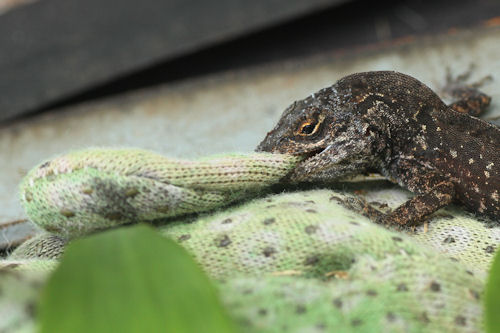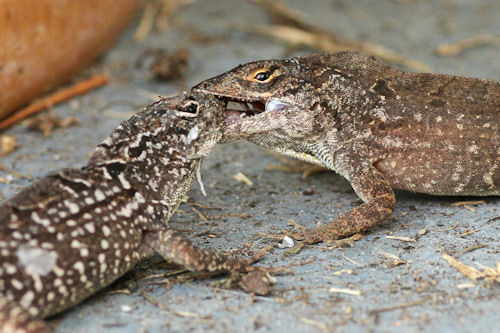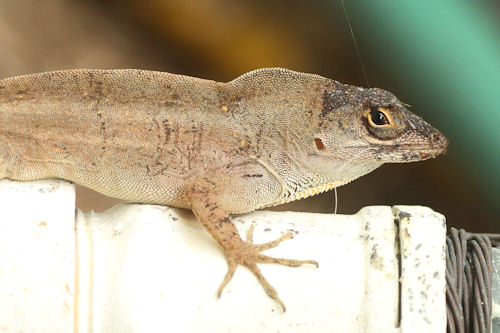httpv://www.youtube.com/watch?v=uL8Tv5aqn5Q
We here at AA love to put up videos of anoles doing interesting things. Got a favorite? Let us know and we’ll post it.

httpv://www.youtube.com/watch?v=uL8Tv5aqn5Q
We here at AA love to put up videos of anoles doing interesting things. Got a favorite? Let us know and we’ll post it.

Chamaeleolis, the un-anole anole. Does this evolutionary one-off demonstrate that island anole radiations are not convergent? Photo by Veronika Holanova and more on this snail crunching anole in a previous post.
Stephen Jay Gould famously proclaimed that if the tape of life were rewound and played again, a different evolutionary outcome would result. He argued that chances events–a lightning strike, a particular mutation–would send evolution careening down a different path. Gould’s idea has been controversial and provocative, but also untestable beyond the confines of the laboratory (you actually can replay the tape of life with microbes, but that’s another story).
The next closest possibility is to look at closely related species evolving in similar environmental settings. These “natural experiments” are in some ways a test of Gould’s hypothesis–will evolution from a similar starting point, in similar environments, unfold in similar ways? Gould would have said no, but what do the lizards say?
The evolutionary radiations of Anolis lizards on the islands of the Greater Antilles are renowned for their convergence, with the same set of “ecomorphs” (i.e., habitat specialists) evolving repeatedly on each island. The existence of the ecomorphs would seem to indicate that, in fact, evolution is deterministic–put an ancestral anole on a Caribbean island and let it evolve, and you get the same ecomorphs each time. But there’s a catch, two of them, actually. First, not all ecomorphs occur on all four Greater Antillean islands. Grass-bush anoles are missing from Jamaica and trunk anoles from both Jamaica and Puerto Rico. Moreover, second, there are some habitat specialists that are unique to a single island, with no ecomorphological counterpart on the other islands. The leaf-litter dwelling Anolis (Chamaelinorops) barbouri from Hispaniola or the Chamaeleolis clade–snail-crunching chameleon döppelgangers–from Cuba, pictured above. These quite distinctive habitat specialists–and a number of others–are evolutionary one-offs, with no convergent counterparts elsewhere.
So, convergence isn’t complete across the Greater Antilles. And that raises the question of whether the island radiations are actually replicated or not. Sure, there are some particular instances of convergence, but it’s always possible that these are instances embedded in a larger sea of non-convergence. Is island radiation truly deterministic? Are the evolutionary outcomes on the four islands actually more similar than one might expect by chance?

Average distance of species to their nearest neighbor on another island (gray line) is considerably less than would be expected by chance (gray blocks representing the results of many simulation trials; see papers for details on how these simulations were conducted).
A paper just published by Luke Mahler et al. in Science asks exactly that question (disclosure: I’m one of the authors). The paper took two approaches, using data on the morphology of each species (e.g., limb length, head length, number of toepad scales). First, the morphological similarity of each species to all others was quantified, based on these measurements. In this way, the morphological distance (in a statistical sense) to the nearest species on another island could be calculated. We then asked whether species had a nearest neighbor on another island that was closer (more similar) than would be expected by chance. The result is clear, and illustrated by the figure above. The average distance to nearest neighbor is much smaller than expected by chance. In other words, species tend to have convergent counterparts on other islands.

The number of convergent shifts to the same adaptive peak is substantially greater than expected by chance.
The second approach used a new method developed by Travis Ingram and Luke Mahler which estimates the underlying macroevolutionary landscape. To make a long story short, based on phylogenetic relationships of species and their morphology, the method identifies the minimum number of adaptive peaks across all islands. Convergent evolution would be indicated by unrelated species evolving to occupy the same peaks. The results indicate that there is far more convergence than expected by chance. This result indicates that the underlying macroevolutionary landscape on the islands is similar on the four islands, thus driving evolutionary diversification to occur in similar ways. The idea of the macroevolutionary landscape traces back to famed paleontologist George Gaylord Simpson, and this study is perhaps the first to explicitly test the idea that similarity in the macroevolutionary landscape is what leads to replicated adaptive radiations.
So, Gould seems to have gotten it wrong–let anoles diversify in similar settings, and the outcome will be very similar. Not identical–perhaps revealing the importance of his so-beloved historical contingencies–but pretty darn close, much more so than one would expect by chance. Now, in Gould’s defense, there is reason to believe (because he once told a reporter so) that he didn’t mean his tape rewinding metaphor to apply to the minor dabblings of insignificant little lizards; rather,he was concerned about grand patterns, deep in evolutionary time, when evolution was much less constrained and life was still exploring vast horizons and testing its limits.
Regardless, there is one last Gouldian twist. Anoles have been diversifying on these islands for tens of millions of years. So, the fact that the placement of the adaptive peaks is so similar suggests that there is a long-term stability to the macroevolutionary landscape. Such a long term arrangement would lead to lack of evolutionary change. As we all know, evolutionary stasis was another of Gould’s favorite ideas, so it would seem that SJG went one-for-two with anoles, a .500 average good enough for the all-star team in many leagues.
If you want to more on this paper, there’s a nice article/interview of Luke Mahler by Ed Yong on the Phenomena: Not Exactly Rocket Science website.

New guy on bottom. Photos by Karen Cusick.
Daffodil’s Photo Blog reported a follow-up on Monday’s sagrei smackdown. Round 2 went on for at least 40 minutes yesterday–vicious, wide-ranging, and at times comical–and the young dude got his comeuppance! Serves him right.

Gardening glove takes a beating.
The anole talks at the 2013 Herp Meetings have focused on speciation, hybridization, and systematics. Dr. Gunther Köhler of the Senckenberg Museum in Germany presented his talk on anole genital diversity on Saturday.

Slide from Gunther’s talk, demonstrating striking differences in hemipenial morphologies in sister species pairs.
Genital morphology in anoles is an understudied yet promising area of research. Although hemipenial morphology is a good indicator of phylogenetic relationships in other squamates, anoles are a different case. There is a massive range of diversity in hemipenis size, shape, and ornamentation within Anolis. Unexpectedly, closely related species pairs have very differently shaped hemipenes, despite their external morphological similarities. This suggests that changes in genital morphology evolve very quickly in Anolis.
Along contact zones of closely related species, individuals with intermediate hemipenial morphologies are found. This result is confirmed by looking at hemipenial morphologies of hybrids produced in the laboratory. Not only does hybridization occur, but this phenomenon raises the question of functional neutrality for anole genital morphology. Does having the “wrong” hemipenis shape matter for reproductive success?
There is a strong correlation between female cloacal morphology and male hemipenis morphology, which would suggest that shape does, indeed, matter. However, there is no evidence of reinforcement along contact zones in the mainland. Differences in hemipenial morphology does not prevent hybridization, indicating that a “key-lock” mechanism is not operating in anoles.
As Gunther says, there are more questions than answers when it comes to this phenomenon. There are many potential projects for investigating the genetics of genital morphology of both sexes, as well as the role genital morphology plays in speciation, if any. I am excited to see if answers to these questions develop in the future.
Over at Daffodil’s Photo Blog, Karen Cusick reports on an intense battle between two brown anoles. Where did this new champion come from? And how will he be stopped?


The king is dead (or at least chased off). Long live the king!
With the 2013 Herp Meetings in Albuquerque coming to a close, there have been some great anole posters presented over the 3 poster sessions. I spoke with some of the presenters about their exciting results.
SSAR Student Poster Winner Kristin Winchell of the Revell Lab studied differences in morphology in urban and natural Anolis cristatellus populations in Puerto Rico. Kristin found that urban populations had longer limbs, more subdigital lamellae and higher body temperatures than natural populations of lizards. She believes these morphological features are adaptations for clinging to the broad, smooth surfaces of an urban landscape. She will continue this work by using a common-garden setup to rule out phenotypic plasticity as the cause of these differences. This is an interesting study that will hopefully inspire more research on how reptiles will adapt to an increasingly urban world. You can read more about Kristin’s research on her website. Congratulations Kristin!
Continuing with the theme of anoles in human-mediated environments, Ian Latella of the Poe lab presented his poster on changes in a small, introduced Anolis community. An assemblage of six introduced species reside in All-America Park in Miami: A. distichus, A. equestris, A. garmani, A. porcatus, A. sagrei, and A. cristatellus. This provides a natural experiment for investigating invasion dynamics and short-term community assembly. Ian compared data on habitat use from 2002 and 2012 to identify changes across time. The preliminary results are interesting: after a 10 year period, A. sagrei utilized higher perches, while A. porcatus switched to lower perch heights.
Aja King, also from the Poe lab, was interested in comparing A. allisoni populations in Cuba and the Bay Islands. She constructed a molecular phylogeny containing specimens from Cuban and Bay Island populations. Her phylogeny showed that the Bay Island populations nested within an Eastern Cuba clade, suggesting the possibility of an invasion of the Bay Islands from Cuba. Aja also performed a discriminant function analysis to look for differences in continuous morphological characters. She was excited that the Bay Island and Cuban populations were significantly different with respect to morphology: she could correctly identify the island of origin based on specimen morphology every time!
Steven Poe, New Mexico’s local anole expert, presented his poster on Sunday publicizing the lab’s efforts to develop a computerized Anolis key. The key would include all 381 species of Anolis. Rather than a dichotomous key-style approach, the user would check a series of boxes representing character states. The key would then search through the species matching the set of inputted characters. This project would lead to an app-style user interface that researchers could use on the go. This will be a great resource for professional and hobbyist herpetologists alike.
Kirsten Nicholson, professor at Central Michigan University, presented some of the results of her phylogeographic study on Norops capito, a mainland species. Previous hypotheses suggested that members of the Norops group originated in the Caribbean after the separation of North and South America and the break-up of Caribbean islands, dispersing overwater to Mexico and then moving southward. Kirsten’s molecular phylogeny of N. capito shows a contrasting pattern. Panamanian individuals form an outgroup, with Costa Rican, Nicaraguan, and Honduran individuals nested within. This suggests a South->North dispersal pattern. Along with N. limifrons, this is the second species to show this pattern. Kirsten plans to estimate divergence times from her data to further elucidate the picture of anole dispersal.
The 2013 Herp Meetings have showcased an assortment of great ongoing anole projects. What a great venue for drawing the anole community together! Check back soon for more on the conference.

Slide from Anthony Geneva’s talk, showing the placement of the A. d. ravitergum and A. d. ignigularis crosses on the scale of reproductive isolation.
The Joint Meeting of Ichthyologists and Herpetologists kicked off this week in Albuquerque, NM. Anoles are well represented, with 7 posters and 5 talks. During the conference, I will report on some of the exciting work being presented.
Anthony Geneva, Ph.D. student in Rich Glor’s lab at the University of Rochester, gave a proper introduction to the meetings with his talk Friday morning. Anthony’s study investigates the degree of reproductive isolation in the parapatric subspecies pair A. disticus ravitergum and A. d. ignigularis. Each subspecies is genetically and morphologically distinct, though not completely isolated. Along the pair’s contact zone, there is a clinal gradient from a pure red (ignigularis) to a pure white (ravitergum) dewlap. Evidence for introgression in mtDNA haplotypes also follows this clinal pattern, with hybrids existing in the middle of the range. This provides an excellent model system for studying the process of speciation.
Anthony used a classic genetic cross to search for evidence for intrinsic isolating mechanisms in the subspecies pair. The product of these crosses was a whopping 1702 eggs and 857 babies. One convincing result was that hybrid crosses produced a greater proportion of slug (unfertilized eggs) than pure crosses! These results suggest that the barrier preventing coalescence is post-mating, prezygotic isolation. He was able to quantify the degree of intrinsic isolation on the index above, with 0 representing no isolation and 1 representing complete isolation. On this index, the focal Anolis disticus subspecies pair is placed in between the classic speciation model systems of Ficedula flycatchers and Rhagoletis apple maggots.
The presence of post-mating pre-zygotic isolating mechanisms suggests that cryptic female choice and sexual selection play a role in separating the two subspecies. Anthony plans to continue this work by backcrossing hybrid individuals to pure individuals, and hopes to use genetic cline analysis to identify the genomic regions underlying intrinsic isolation.
Over the next few days, I will also post about some of the other Anolis talks and posters here at the JMIH. Check back soon!

The Cover of Anolis Newsletter III, in which Ernest Williams revealed the POUM
Here at AA, we’ve often discussed Ernest Williams’ Principle of Unsympathetic Magic [1,2], which states that any hypothesis formulated in the field will immediately be disproven by the next observation. Janson Jones has recently uncovered its corollary, the Kakakairos of the Unprepared, which proclaims that whenever one goes into the field without a piece of equipment that one normally has, a situation will arise in which that equipment is needed. Or, more generally, whatever one is unprepaped for will happen. Janson explains it much better at Dust Tracks on the Web. All I can say is, it happens to me all the time.
Years ago I heard reports that Anolis cholocyanus had established a small population in Dade County. Does anyone know if this population is still viable? I am starting a new project and it would be quite beneficial to examine a few living specimens before investing in a full trip to the Dominican Republic. If anyone has any information about the status of this introduced species I would be extremely grateful to learn more.
Have a good weekend!

Not the greatest photo of a brown anole you’ll ever see, but it’s got one thing others don’t: it’s on Beyonce’s Tumblr page! Under the “my work” category. One can only speculate on its significance.
Powered by WordPress & Theme by Anders Norén